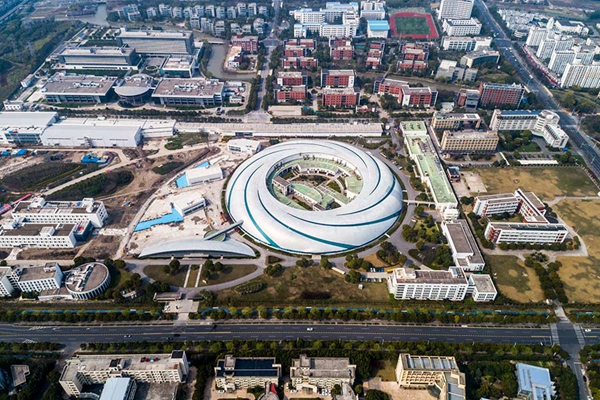China's high-tech hub eyes core technologies, industries

A bird's-eye view of the Shanghai Zhangjiang High-tech Park. [Photo by Wu Jun/for China Daily]
China's high-tech hub Zhangjiang in Pudong New Area, Shanghai, is set to further develop core technologies and industries to help realize the central government's blueprint for Pudong.
The country released a new guideline on July 15 to give full play to Pudong's key role in high-level reform and opening-up and build it into a leading area for socialist modernization.
The 14th Five-Year Plan (2021-25) for the development of Zhangjiang, which was issued by Shanghai the day after the guideline was released, proposes that Zhangjiang would by 2025 become a source of scientific and technological innovation and a growth catalyst for high-end industries.
Pudong has already taken the lead in building collaborative innovation ecosystem. It released a large enterprise open innovation center plan on July 29 that called for open cooperation between leading science and technology companies.
Among the first batch of large enterprises to be a part in the plan was Roche, the first multinational company to settle in Zhangjiang.
In 1992, the Shanghai Zhangjiang High-tech Park was established, covering an area of only 17 square kilometers. When Roche set up its first factory in China there in 1993, the area was just a piece of farmland.
Today, Zhangjiang has been transformed from a farmland to a high-tech hub, and Roche's factory there has evolved from a pharmaceutical factory to an open innovation center that helps incubate local scientific research.
A pioneer for science and technology innovation
From the Zhangjiang High-tech Station on Shanghai Metro Line 2, one can take a short walk to the Shanghai Microelectronics Port and ZTE R&D building and see leading IC companies such as SMIC and Huahong Hongli Semiconductor Manufacturing Co Ltd in the east.
"When established in 2004, we chose to independently develop China's plasma etching machine," said the person in charge of China Micro Semiconductor Equipment (Shanghai) Co Ltd founded in Zhangjiang.
Like the lithography machine, the plasma etching machine is also a key equipment for micro-processing of semiconductor chips. After more than 10 years of exploration, the company has successfully mastered the 5nm etching machine manufacturing technology and become a leading semiconductor equipment company in the country.
In the past two years, Zhangjiang has made continuous breakthroughs in core IC technologies, achieving mass production of 14-nanometer process chips, breakthroughs in the 12-nanometer process development, and mass production of the third-generation of the 90-nanometer embedded flash memory process platform.
Driven by independent innovation, 217 IC-related companies have gathered in Zhangjiang and formed the most complete IC industry chain in China.
The breakthroughs in core technologies are closely linked to the heavy investments in basic research. Zhangjiang's power also lies in its large scientific facilities that provide support for many scientific research projects.
The world's first 10-petawatt laser experimental device - Shanghai's ultra-strong and ultra-short laser experimental device - is located in Zhangjiang.
Leng Yuxin, deputy director of the Shanghai Institute of Optics and Fine Mechanics, Chinese Academy of Sciences, said that the device has achieved multiple technological breakthroughs, including setting a world record for the highest laser peak power.
Because of this device, the institute managed to successfully develop the world's largest-diameter Ti:Sapphire crystal and other core components.
The device is now used to support experiments such as proton acceleration, electron acceleration, high-brightness plasma high-order harmonics, and attosecond pulse generation.
The scientific research team will next aim to develop a 100-petawatt laser device. "During the device installation process, the project was approved and started construction quickly thanks to the support of the government of Shanghai and Pudong," said Leng.
Leng hoped that the new guideline could help attract excellent scientific research talents from all over the world.
Zhangjiang now boasts large-scale scientific devices such as the Shanghai Light Source, the National Protein Science Research Facility, and the ultra-strong and ultra-short laser experimental device, which will give a boost to local scientific and technological innovation.
A pole of high-tech industrial growth
After nearly 30 years of rapid development, Zhangjiang has expanded from its initial 17 sq km to 220 sq km. In 2020, its total output value of industries above designated size exceeded 300 billion yuan ($46.18 billion).
With the commencement of construction of the leading area, Zhangjiang is undertaking the development of Pudong's six core industries: chipmaking, innovative drugs, commercial civil aviation, new energy vehicles, smart manufacturing and big data.
A core area for smart manufacturing, Zhangjiang Robot Valley was officially established at the end of 2020. This area is expected to provide a development space of 1 million sq m for the robot industry during the 14th Five-Year Plan (2021-25) period.
Cutting-edge scientific and technological achievements of many enterprises in the valley and the future application scenarios of robots are now being displayed at a 1,000-square-meter exhibition hall which opened in Zhangjiang Robot Valley on July 29.
Visitors can view drones, smart baristas, non-contact delivery staff that helped with epidemic prevention and control, and underwater robots that once served on the frontlines of flood prevention and relief efforts.
"To build a world-class innovative industry cluster, robots are one of the most important tracks," said Wang Tao, manager of the investment service department of Shanghai Pudong Kangqiao (Group) Co Ltd and the person in charge of the Zhangjiang Robot Valley project.
By the end of 2025, Zhangjiang Robot Valley is expected to achieve an overall industrial scale of 70 billion yuan and become home to 150 core robot companies and 10 listed companies, making it a development highland and innovation center for the robot industry with global influence, Zhang said.
Set up in Zhangjiang six years ago, Shanghai Fourier Intelligent Technology Co Ltd started out as a two-person entrepreneurial team and has since grown into the only domestic rehabilitation robot company that exports to Europe and the United States.
"Training that previously required 20 or 30 rehabilitation therapists now only requires one or two therapists who control the robot," said Gu Jie, chairman and CEO of the company, before adding that given the backdrop of an aging population, rehabilitation robots not only have social value but also broad application prospects.
The company moved its headquarters to Zhangjiang Robot Valley in July this year because of the concentration of professional talents, the obvious industrial advantages, and the accumulation of a strong foundation for smart manufacturing in Zhangjiang, Gu added.
"One to two years later, we will create an interconnected environment between upstream and downstream enterprises, business models, and talent training in the valley," said Gu, who added that he was looking forward to seeing more favorable policies released.
With the continuous implementation of relevant policies, more and more innovative elements will allow Zhangjiang to fulfill it innovation potential to the fullest.

 Print
Print Mail
Mail




